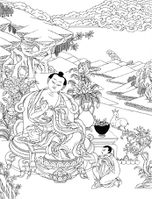Asaṅga: Difference between revisions
No edit summary |
No edit summary |
||
| Line 13: | Line 13: | ||
|AltNamesOther=Āryāsaṅga | |AltNamesOther=Āryāsaṅga | ||
|YearBirth=4th Century | |YearBirth=4th Century | ||
|ReligiousAffiliation=Yogācāra; Cittamātra | |DatesNotes=The dates for this master are uncertain, though it is generally assumed that he lived in the 4th or 5th centuries. | ||
|ReligiousAffiliation=Yogācāra; Cittamātra; Vijñānavāda | |||
|PersonalAffiliation=Vasubandhu | |||
|BdrcLink=https://www.tbrc.org/#!rid=P6117 | |BdrcLink=https://www.tbrc.org/#!rid=P6117 | ||
|images=File:Asanga (R. Beer).jpg{{!}}Line Drawing by Robert Beer Courtesy of [http://www.tibetanart.com/ The Robert Beer Online Galleries] | |images=File:Asanga (R. Beer).jpg{{!}}Line Drawing by Robert Beer Courtesy of [http://www.tibetanart.com/ The Robert Beer Online Galleries] | ||
|BnwShortPersonBio= | |BnwShortPersonBio=Traditionally counted among the Seventeen Great Paṇḍitas of Nālandā, Asaṅga was an illustrious Indian scholar who, along with his brother Vasubhandu, is credited with the founding of the Yogācāra school and the introduction of their associated theories of mind-only (''cittamātra''), the storehouse consciousness (''ālayavijñāna''), and the three natures (''trisvabhāva'') into the milieu of Buddhist philosophy. He most famously eulogized in the Tibetan tradition for his association with the Five Treatises of Maitreya, which he is reported to have received directly from the Bodhisattva Maitreya. In terms of the ''Uttaratantra'', the Tibetan tradition asserts that he was the author of the prose commentarial sections (''vyākhyā'') of this work, while Maitreya, himself, is the author of the actual verses of the treatise (''śāstra''). | ||
|IsInGyatsa=No | |IsInGyatsa=No | ||
}} | }} | ||
Revision as of 14:21, 17 July 2018
| PersonType | Category:Classical Indian Authors |
|---|---|
| MainNameTib | ཐོགས་མེད་ |
| MainNameWylie | thogs med |
| MainNameSkt | Asaṅga |
| AltNamesTib | སློབ་དཔོན་ཐོགས་མེད་ |
| AltNamesWylie | slob dpon thogs med |
| AltNamesOther | Āryāsaṅga |
| YearBirth | 4th Century |
| DatesNotes | The dates for this master are uncertain, though it is generally assumed that he lived in the 4th or 5th centuries. |
| ReligiousAffiliation | Yogācāra; Cittamātra; Vijñānavāda |
| PersonalAffiliation | Vasubandhu |
| BDRC | https://www.tbrc.org/#!rid=P6117 |
| IsInGyatsa | No |
| BnwShortPersonBio | Traditionally counted among the Seventeen Great Paṇḍitas of Nālandā, Asaṅga was an illustrious Indian scholar who, along with his brother Vasubhandu, is credited with the founding of the Yogācāra school and the introduction of their associated theories of mind-only (cittamātra), the storehouse consciousness (ālayavijñāna), and the three natures (trisvabhāva) into the milieu of Buddhist philosophy. He most famously eulogized in the Tibetan tradition for his association with the Five Treatises of Maitreya, which he is reported to have received directly from the Bodhisattva Maitreya. In terms of the Uttaratantra, the Tibetan tradition asserts that he was the author of the prose commentarial sections (vyākhyā) of this work, while Maitreya, himself, is the author of the actual verses of the treatise (śāstra). |
| Other wikis |
If the page does not yet exist on the remote wiki, you can paste the tag |

